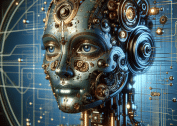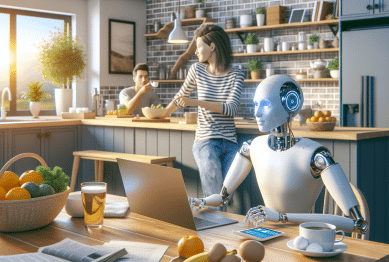Explore how artificial intelligence, or AI, is rapidly reshaping daily experiences through smarter devices and advanced problem-solving. This guide uncovers practical uses of AI, from smart assistants to healthcare breakthroughs, and walks through the real benefits people can access today through this groundbreaking technology.
What Artificial Intelligence Really Means
Artificial intelligence, often abbreviated as AI, is the science of making machines think and learn in ways similar to human beings. By processing enormous sets of data and identifying patterns, AI enables computers to make predictions, solve problems, and even understand natural language. The keyphrase ‘artificial intelligence’ continues to gain interest as its presence grows in both personal devices and broader industry applications. But what does that mean for individuals in their everyday lives? Understanding the basics of AI—how it recognizes voices, recommends content, or even powers vehicles—helps demystify some of the latest tech headlines seen across digital platforms.
Modern AI harnesses techniques such as machine learning, where algorithms train themselves to improve at a specific task over time. There are also neural networks inspired by the way the brain works, which are behind features like image recognition and language translation. These approaches make artificial intelligence adaptable, enabling it to personalize recommendations for users on streaming platforms or respond to increasingly complex conversational needs in customer service bots. AI is not limited to massive research labs; it’s in phones, cars, thermostats, and even vacuum cleaners, weaving its way into daily routines almost invisibly.
Behind every fascinating AI innovation are intricate frameworks that transform huge amounts of raw data into outcomes people can actually use. For instance, smart assistants such as Alexa or Google Assistant rely on advanced natural language processing—a subfield of AI that interprets spoken requests and delivers answers or actions. This is just the start. As algorithms gain more access to data, their ability to learn accelerates, opening possibilities for even more personalized experiences. Many experts believe we’re only scratching the surface when it comes to the daily impact of artificial intelligence, and tech watchers are keen to keep up with each development.
Everyday Technologies Enhanced by AI
AI-powered gadgets have become near essentials in the modern household. Smart home devices use machine learning to regulate temperature, optimize lighting, and even enhance home security. Many users experience these conveniences through voice-activated assistants that use AI to interpret requests like playing music or setting reminders. These are not luxury items; their affordability and ease of use make AI a regular part of life for many, though their inner workings often remain a mystery to users seeking guidance.
Artificial intelligence is also transforming online experiences. Algorithms in search engines anticipate what people are looking for and adjust results accordingly, improving efficiency for users searching for information, directions, or entertainment. Social media platforms rely on AI-driven content curation to display posts or ads most likely to capture interest. These personalized experiences, while common today, are built on layers of machine learning and data analysis that evolve in real time as people interact more with digital services.
In transportation, AI has enabled incredible breakthroughs such as self-parking vehicles and adaptive cruise control, which adjust speed based on traffic flow. Navigation apps compile road data from millions of drivers, helping commuters avoid traffic jams and save time. For businesses, AI-powered chatbots handle customer queries with impressive efficiency, freeing up human employees for more complex tasks. These practical applications rely on complex algorithms but routinely deliver straightforward solutions designed to make daily routines smoother for millions of individuals.
Smart Assistants and the Growth of Voice AI
One of the most visible faces of artificial intelligence is the smart assistant. Whether on smartphones, speakers, or smartwatches, these digital helpers have changed how people interact with technology. Asking a device to send a message, find a recipe, or read the news has become seamless through advances in natural language understanding. Apple’s Siri, Amazon’s Alexa, and Google Assistant process speech, context, and even subtle user cues to provide relevant answers. This technology’s ability to evolve over time promises new convenience, even for those just beginning to explore AI-powered tools in daily life.
Voice recognition accuracy is powered by deep learning, enabling devices to recognize accents, learn new vocabulary, and adapt to different household voices. This accessibility has made AI-driven voice technology particularly useful for individuals with disabilities, presenting new opportunities for greater independence. Smart speakers now support home automation, reading reminders, and even playing trivia games, all through simple spoken commands. Usage of these tools continues to surge as people discover new ways to incorporate AI’s convenience into their everyday routines.
The future of smart assistants suggests even more integration with personal and professional routines. Imagine a device that schedules meetings, orders groceries, and adjusts lighting based on mood or time of day—all triggered by verbal requests. This doesn’t require technical expertise to use; smart assistants are designed to learn user preferences gradually and subtly, highlighting how artificial intelligence quietly transforms the way people live without demanding a steep learning curve. As this area evolves, robust privacy controls and ethical considerations are becoming vital talking points for developers and users alike.
Healthcare Innovations Fueled by Artificial Intelligence
AI’s influence in healthcare is perhaps one of the most life-changing examples of its real-world value. From diagnostic imaging to drug discovery, machine learning algorithms can analyze medical scans at speeds no human could match. Healthcare AI is growing rapidly, helping professionals make faster, more informed decisions and improving outcomes for patients. For individuals, this means earlier detection of health concerns and greater efficiency during doctor visits. Some hospital systems also use AI to predict patient needs and automate scheduling, highlighting the wide-ranging benefits already coming to life (Source: https://www.nih.gov/news-events/artificial-intelligence-medicine).
Wearable devices—like smartwatches and fitness trackers—leverage machine learning to monitor vital signs, detect abnormal rhythms, and offer suggestions for healthier lifestyles. AI intervenes when users need reminders to move or rest and can record data for sharing with healthcare providers. Such instant access to personalized health data enables more proactive choices and places the power of wellness in users’ hands. In the background, sophisticated computer vision technologies help physicians interpret everything from X-rays to pathology slides, continually improving with each case reviewed.
Researchers are also exploring how artificial intelligence can streamline administrative tasks, freeing up clinicians’ time and reducing errors. Automated systems help manage patient records and schedule follow-ups, while chatbots can offer answers to basic questions without taking up valuable staff time. The combination of improved diagnostics and automated care management gives healthcare professionals new tools to deliver higher-quality care and improve patient satisfaction (Source: https://www.healthit.gov/topic/scientific-initiatives/precision-medicine/artificial-intelligence-healthcare).
Ethical Considerations and Responsible AI Use
As artificial intelligence becomes more embedded in daily processes, ethical considerations are at the heart of ongoing innovation. AI learns from huge data sets, which raises questions about privacy, fairness, and accountability. Developers and policymakers are increasingly focused on making sure algorithms do not amplify bias or invade personal space. Industry guidelines now require transparency about how data is used and greater oversight to protect users, particularly where AI impacts sensitive information (Source: https://www.brookings.edu/research/ethics-of-artificial-intelligence-and-robotics/).
In addition to privacy, conversations about responsible use are shaping the way businesses deploy AI. Regulators and advocacy groups are keen on setting boundaries, particularly where automation affects livelihoods or critical decision making. Transparency in AI systems lets users understand how decisions are made—whether in banking, hiring, or healthcare— fostering trust and informed consent. There is also growing interest in developing AI that is explainable, ensuring users and experts alike can review outcomes and challenge unexpected results when necessary.
Ethics in artificial intelligence is not just a theoretical concern. Examples abound, such as automated resume screening tools or credit assessments, where even unintentional bias can have serious consequences. Organizations are urged to audit their systems, engage diverse teams in development, and seek feedback from end users. In turn, ordinary people should ask questions about how their data is collected and utilized, supporting an ecosystem where intelligent technology serves society’s broader interests without causing unintended harm (Source: https://www.nist.gov/artificial-intelligence).
Learning and Adapting Alongside AI
People are constantly adapting to new ways technology influences work, leisure, and learning. AI-powered platforms are providing personalized learning experiences in education, helping students grasp tough subjects or access resources tailored to their needs. Digital tutors offer instant feedback and adapt lessons based on student performance, ensuring that individuals at all stages of life have clearer guidance on reaching their goals. This trend is accelerating as educators and policymakers see the value in scalable, adaptive technology that complements traditional teaching methods (Source: https://www.ed.gov/ai).
Online courses, many of which use artificial intelligence to evaluate progress and recommend future study topics, have revolutionized professional development. AI-driven analytics flag learners’ strengths and areas for improvement, streamlining the path toward new skills. For businesses, this means faster upskilling of teams, while individuals gain access to new career opportunities. As more platforms invest in AI-based learning paths, the process of education is set to become even more customized and effective.
Beyond formal education, AI also supports lifelong learning through content recommendations, virtual workshops, and interactive games that boost cognitive skills. Mobile apps can track personal growth or language acquisition, adapting difficulty as proficiency increases. The combination of accessibility, cost-effectiveness, and tailored feedback demonstrates artificial intelligence’s potential to transform self-improvement. It empowers users to steer their own development with clearer feedback and less frustration, underscoring the technology’s broad appeal.
References
1. National Institutes of Health. (n.d.). Artificial Intelligence in Medicine. Retrieved from https://www.nih.gov/news-events/artificial-intelligence-medicine
2. U.S. Department of Health and Human Services. (n.d.). Artificial Intelligence in Healthcare. Retrieved from https://www.healthit.gov/topic/scientific-initiatives/precision-medicine/artificial-intelligence-healthcare
3. Brookings Institution. (n.d.). The Ethics of Artificial Intelligence and Robotics. Retrieved from https://www.brookings.edu/research/ethics-of-artificial-intelligence-and-robotics/
4. National Institute of Standards and Technology. (n.d.). Artificial Intelligence. Retrieved from https://www.nist.gov/artificial-intelligence
5. U.S. Department of Education. (n.d.). Artificial Intelligence (AI). Retrieved from https://www.ed.gov/ai
6. Stanford University Human-Centered Artificial Intelligence. (n.d.). Artificial Intelligence Index Report. Retrieved from https://hai.stanford.edu/research/artificial-intelligence-index-report









